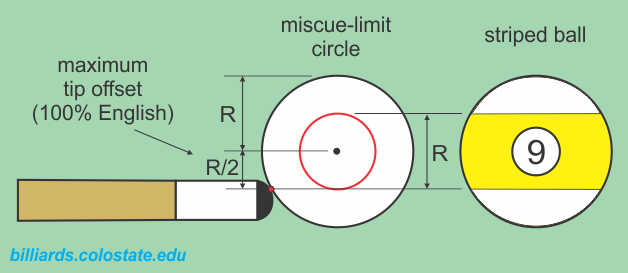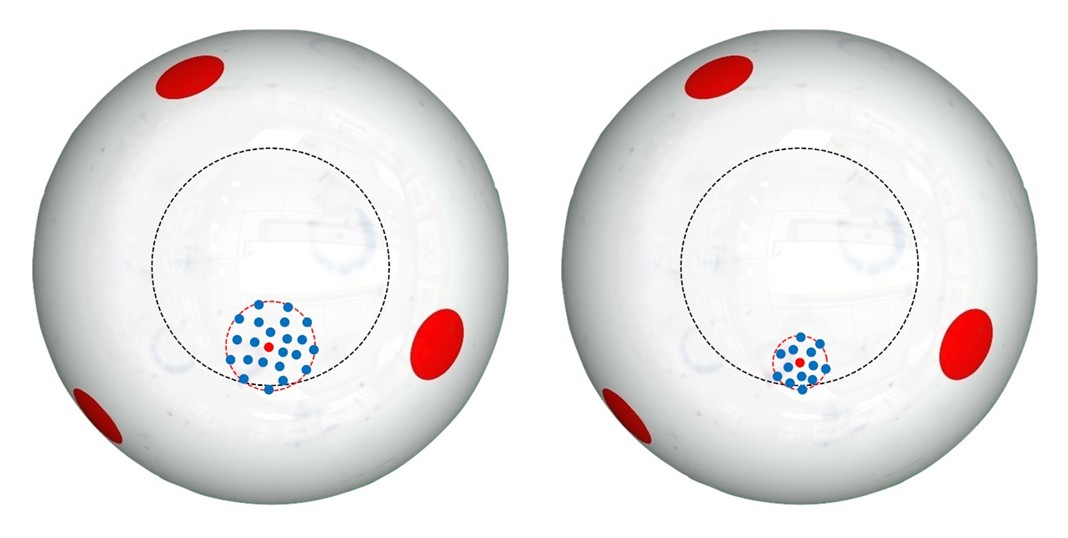How can I get the most possible spin on the cue ball?
In general, to get maximum spin, prepare and chalk a good tip, and hit the cue ball as far from center as you can without miscuing (see the miscue resource page for examples and more info). A standard striped ball can be useful for practice because the width of a standard stripe is half the ball’s diameter (NOTE – this is not the case with all ball brands), and the edges of the stripe border the typical miscue limit (at half the ball’s radius from center). Here’s a useful illustration of maximum (100%) spin:

And here’s a demonstration along with how to verify the stripe width:
For more information, see:
- “Top 10 Draw Shot Tips” (BD, March, 2020).
- “Draw Shot Primer – Part VII: tips of english” (BD, July, 2006).
- “Coriolis was brilliant … but he didn’t have a high-speed camera – Part IV: maximum cue tip offset” (BD, October, 2005).
Tip size and shape can also affect the amount of spin you are getting. For more info, see:
Maximum tip-offset considerations also apply to follow and draw shots. For more info, see:
As shown by the following illustration from Patrick Johnson, a shooter with better tip contact point accuracy and precision can safely aim lower on the CB, and typically get more backspin, than a shooter with less accuracy and precision:

For more information about how to achieve maximum draw, see:
- draw shot technique advice
- power draw
- draw cue elevation effects
- draw shot cue weight effects
- quick draw
To achieve the most effect from sidespin (for example, get the most rebound angle change off a cushion), you want to use a drag shot where you start the CB off with backspin, and the backspin wears off on the way to the cushion (increasing the spin-speed ratio). The problem with hitting below center is that you must decrease the amount of sidespin (tip offset) a little. However, because the drag action slows the cue ball while retaining most of the sidespin, the rebound angle will be larger. For more info, see the drag shot resource page.
Some people think low-CB-deflection (LD) shafts or tip type/hardness/brand or chalk brank or other things can help you get more spin on the CB, but this is not the case. For more info see:
- getting more spin with low-squirt cue
- cue tip hardness effects
- chalk comparison resource page
- effect of squirt on miscue limit
When using a very heavy and/or stiff cue, the maximum tip offset (and maximum spin) possible with a good hit can be more limiting than normal (see optimal cue weight). As shown in the plots on pages 7 and 8 in TP A.30, with a hit close to the miscue limit, the CB might not separate from the tip fast enough. Also, with a stiff shaft (e.g., a carbon fiber shaft) the end of the cue won’t deflect away from the ball as much as normal and will tend to flex back toward the CB faster (see cue vibration for video illustrations). These effects can result in a double hit or push that might not even be directly noticeable; although, the CB will squirt more than expected (as with a miscue shot). The 2nd-to-last shot (before the miscue) in HSV A.106 visually shows how close the tip can come to a double hit even with a typical-weight LD shaft, which is not very stiff. For more info on this topic, see “Coriolis was brilliant … but he didn’t have a high-speed camera – Part IV: maximum cue tip offset” (BD, October, 2005). Another example of this from 2008 testing of a prototype cuttlefishcues carbon fiber shaft showing how a stiff shaft does not deflect away from the CB as much, and returns to the CB quickly, risking a double hit (see the shots with the black shaft in the video). Here are some clear examples of the effect:
from Jal:
Sidespin (english) is used on the majority of shots to either control how the cueball comes off a cushion, or to reduce object ball throw (with outside english). In both cases, it is the amount of spin relative to the speed of the cueball that is important – the spin/speed ratio. This is governed nearly totally by tip offset, ie, how far from center tip contact is made. Cue speed and weight have a very slight effect. The heavier and faster the cue, the greater the spin/speed ratio (very slightly).
The factors that govern absolute spin rate, as with force follow and draw shots, have been mentioned (tip offset and cue speed), but just to add this. For any particular player, there is an optimal cue weight, one that produces the most spin, for each particular offset. No one cue will work equally well at all offsets for that player. But the good news is that over a rather broad range of cue weights, there is very little difference between them as far as cueball response. (The reason for this has to do with with the inertia of the player’s arm.) Nevertheless, as a general rule, a heavier cue is more efficient at centerball, while a lighter one is more efficient away from centerball (in theory).
I would think that harder tips would be more efficient than softer ones, but some tests done by another poster here, Mike Page, suggest that this might not be the case, that they may be about the same. This is a part of cue efficiency as a whole. I suspect that there is very little difference between the “best’ and “worst” cues as far as overall efficiency is concerned.
In brief, the principle factors (and virtually the only factors) are tip offset for spin/speed ratio, and tip offset plus cue speed for absolute spin rate. Having a well-chalked tip in good condition is important too, of course, as it determines how far from center you can hit.
from dr_dave:
Excellent summary!
For people who use “tips of english,” tip shape can also affect the amount of spin they apply. For illustrations and explanations, see the “tips” of spin resource page.
For people who want to see the math and physics behind many of Jal’s statements above, see TP A.30.
Dr. Dave keeps this site commercial free, with no ads. If you appreciate the free resources, please consider making a one-time or monthly donation to show your support:
